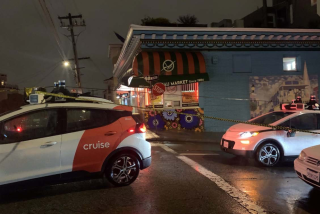Automatic Gate Safety at Issue
- Share via
Federal safety officials are asking the public to help them crack down on hazardous automatic security gates that entangle thousands of children and adults each year, causing serious injury and even death.
The U.S. Consumer Product Safety Commission said in an alert being issued today that many older gates lack safety features, such as automatic sensing devices, that could prevent people from becoming trapped.
Since 1985, the safety commission has discovered 32 deaths, 20 of them children, related to automatic gates. Each year, more than 2,000 people, including 800 children, are treated in hospital emergency rooms for cuts and lacerations, broken bones, hematomas and amputations.
“These are serious injuries and deaths to children and adults who became trapped because the gates didn’t stop or reverse,” safety commission spokesman Scott Wolfson said Monday. “People who tried to come to the rescue weren’t able to loosen the mechanisms, and emergency crews are having to use the jaws of life to free people. These gates can take off a limb or compress a chest easily.”
The sliding or swinging gates, usually made of wrought iron bars, are found at the entrances of homes, apartment buildings and condominiums, parking lots, garages and commercial establishments.
Wolfson said adults are more likely to become entangled in gates located at entrances to businesses or factories, whereas children usually are injured at homes and apartments, typically while playing around a gate or standing on one while it is moving.
In a 1993 case, F. Marlow Santos, 8, was playing tag with another boy at his Gardena apartment building when he tried to slip through the bars of a gate as it began to open.
Bushes had overgrown the gate and blocked the view of the driver who activated a remote control, said the boy’s aunt, Michelle Talbert.
The gate lurched and crushed the boy’s chest. He went into cardiac arrest and died 17 days later, said Talbert, who, with her sister Julie Gillette, has worked since the accident to raise awareness of safety concerns.
“These gates are wonderful if they’re reasonably safe and they need to be reasonably safe,” said Talbert, who now lives in Indianapolis. “People should not get lulled into a false sense of security. These things weigh over a ton and even adults are being killed. People should be more consumer oriented; ask your apartment building manager to make sure gates are as safe as they can be.”
The safety commission worked with Underwriters Laboratories to develop tougher safety standards for automatic gates. They include two mechanisms to prevent accidents: a sensing device that will reverse the gate if it encounters an obstruction, and a second sensor, such as an electric eye, that will reverse the gate if an obstruction is detected.
Other safety measures include locating controls away from the gate, eliminating pinch points and covering rollers and chains. Underwriters Laboratories adopted the safety standards in March 2000, and most manufacturers of new gates have complied. But the standards are voluntary, Wolfson said, and many older gates have not been modified.
More to Read
Sign up for Essential California
The most important California stories and recommendations in your inbox every morning.
You may occasionally receive promotional content from the Los Angeles Times.














